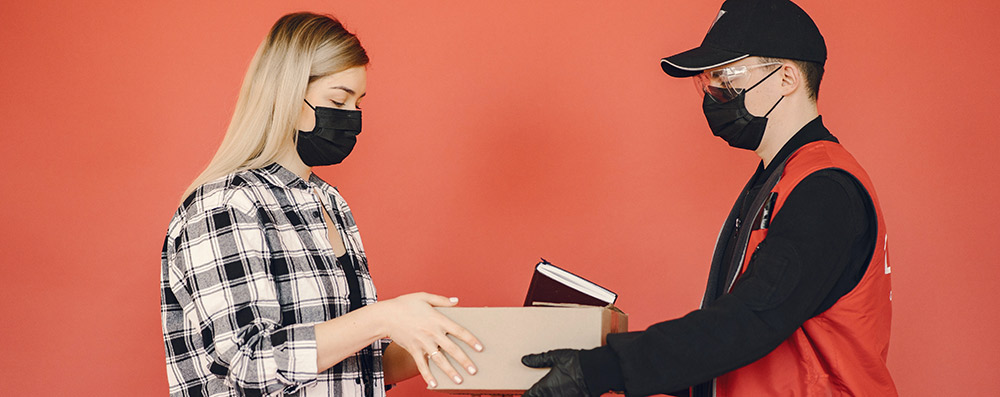I’ll spare you the buzzwords, but it’s no secret the economic side effects of COVID-19 have been seismic, forcing companies to re-think the way they interact with consumers.
Naturally, one side effect of the pandemic is our heightened awareness of hygiene and safety concerns. Consumer purchasing decisions have already dramatically changed, and the demand for sanitary packaging and delivery methods is unlikely to diminish even as the world emerges from the crisis. In fact, a May survey from Salesforce revealed 62% of people were doing less in-person shopping and are instead choosing to purchase everything from their groceries to cleaning supplies from online retailers.
With these shifting mindsets sure to outlast the pandemic, here are a few ways you can adapt your printing strategies in a COVID-19 world:
1. Design with hygiene in mind.
One July study found that 40% of U.S. consumers will use household disinfectants to clean the products they buy. The fear of contracting the coronavirus from surfaces has impacted consumers’ willingness to buy certain products, and has ushered in a new, hygienic standard for packaging.
What are the long-term implications of this? Consumer journey maps will have to be re-charted to accommodate a hygiene-focused market. As companies pivot to meet new consumer demands, brands are choosing to innovate their packaging design and printed materials.
Door hangers are a good example. Used by everyone from political candidates to pest control companies to lawn care services, companies are re-thinking how consumers interact with these printed marketing pieces. To help one of our recent customers overcome this challenge, we attached rubber bands to the door hangers to minimize physical contact with the paper. This simple change meant the piece avoided any unnecessary exposure to the virus, which further helps protect consumers.

Another trending strategy is the incorporation of both primary and secondary packaging, which provides a sanitary layer to protect the product inside from unnecessary contact during shipping. In addition to secondary packaging, many brands are using tamper-proof labels, giving consumers a sense of security.
2. Focus on the unboxing experience.
Brands are always looking for new ways to bring an experience to their customers. As shoppers shift their buying habits away from traditional brick-and-mortar stores, successful brands are placing renewed importance on the product unboxing experience.
This experience is crucial in developing a relationship with your customers and provides them the same thrill as finding an item in-store. Branded or personalized packaging will also make your product stand out among other non-descript packages on our doorsteps. Also, try including printed inserts with product instructions or upcoming sales to allow the consumer to interact with your brand or product in a way that doesn’t feel artificial.
Even with the advent of two-day shipping, the time between purchase and delivery leaves consumers anticipating the arrival of their package. Consider investing in custom-printed stickers, tissue paper and thank-you cards to give your product a more luxury feel, helping to eliminate any post-purchase cognitive dissonance (better known as buyer’s remorse).
3. The comeback of catalogs.
Even before the pandemic, catalogs were making a comeback. The Harvard Business Review found that Millennials – contrary to their digital reputation – are particularly interested in receiving catalogs (especially those that are well-designed). The same study also proved their ROI—boosting sales in an otherwise email-only campaign by 15%, resulting in a $90 increase in purchase amount per customer.
The pandemic has consumers seeking “new” ways of shopping from home. The tactile nature of print – coupled with strong imagery and high-quality print materials – creates a more vivid shopping experience than a typical product webpage. Plus, catalogs and other printed pieces tend to linger in consumer’s homes, remaining on their coffee tables long after that email was deleted.
4. Convenience is still king.
Because shoppers are avoiding physical stores, returning products becomes a time-consuming hassle. While the process is inconvenient for everyone, retailers can make the experience a little less painful with convenient return packaging, such as custom-designed return slips, return packaging or envelopes, and pre-printed shipping labels. Research has shown an easy returns process leaves a customer with a positive impression of your brand, leaving you with a greater chance to re-convert the customer in the future.
Print in a post-pandemic world
Maybe a vaccine for COVID-19 will return our world to “normal,” but brands can bet it won’t be an economic cure-all. Until companies respond to rapidly changing consumer concerns for health and safety, the world will remain at our current decelerated pace.
The good news is that companies can take advantage of printed materials – from unboxing to catalogs – to create an at-home branded experience. Constraints breed creativity, and the pandemic demands that brands innovate the way they reach consumers. Whether you’re a local Kansas City business re-thinking your business model or a national company re-strategizing your marketing efforts, print will remain a unique medium to foster customer relationships with.
Dan Woehrman is owner of Callender Printing, offering full-service printing capabilities – including letterpress, offset and digital – with union craftsmen quality. Share your thoughts on Facebook or on Twitter @CallenderPrint.


Recent Comments